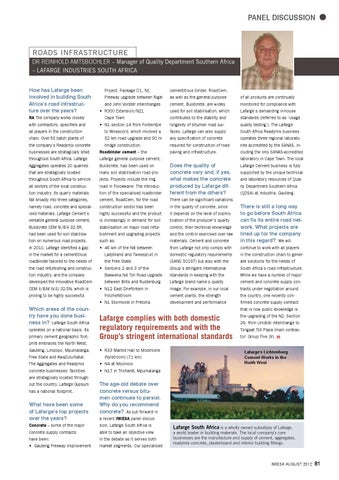PANEL DISCUSSION
ROADS INFRASTRUCTURE DR REINHOLD AMTSBÜCHLER – Manager of Quality Department Southern Africa – LAFARGE INDUSTRIES SOUTH AFRICA How has Lafarge been involved in building South Africa’s road infrastructure over the years? RA The company works closely with contractors, specifiers and all players in the construction chain. Over 50 batch plants of the company’s Readymix concrete businesses are strategically sited throughout South Africa. Lafarge Aggregates operates 20 quarries that are strategically located throughout South Africa to service all sectors of the local construction industry. Its quarry materials fall broadly into three categories, namely road, concrete and specialised materials. Lafarge Cement’s versatile general purpose cement, Buildcrete CEM IV/B-V 32.5R, had been used for soil stabilisation on numerous road projects. In 2010, Lafarge identified a gap in the market for a cementitious roadbinder tailored to the needs of the road refurbishing and construction industry, and the company developed the innovative RoadCem CEM II/B-M (V-S) 32.5N, which is proving to be highly successful.
Which areas of the country have you done business in? Lafarge South Africa operates on a national basis. Its primary cement geographic footprint embraces the North West, Gauteng, Limpopo, Mpumalanga, Free State and KwaZulu-Natal. The Aggregates and Readymix concrete businesses’ facilities are strategically located throughout the country. Lafarge Gypsum has a national footprint.
What have been some of Lafarge’s top projects over the years? Concrete – some of the major concrete supply contracts have been: • Gauteng Freeway Improvement
Project, Package D1, N1 Freeway upgrade between Rigel and John Vorster interchanges • R300 Extension/N21 Cape Town • N1 section 14 from Fonteintjie to Wirasoord, which involved a 52 km road upgrade and 90 m bridge construction. Roadbinder cement – the Lafarge general purpose cement, Buildcrete, has been used on many soil stabilisation road projects. Projects include the ring road in Polokwane. The introduction of the specialised roadbinder cement, RoadCem, for the road construction sector has been highly successful and the product is increasingly in demand for soil stabilisation on major road refurbishment and upgrading projects such as: • 46 km of the N8 between Ladybrand and Tweespruit in the Free State • Sections 2 and 3 of the Bakwena N4 Toll Road upgrade between Brits and Rustenburg • N12 East Driefontein in Potchefstroom • N1 Stormvoel in Pretoria
cementitious binder, RoadCem, as well as the general purpose cement, Buildcrete, are widely used for soil stabilisation, which contributes to the stability and longevity of bitumen road surfaces. Lafarge can also supply any specification of concrete required for construction of road paving and infrastructure.
Does the quality of concrete vary and, if yes, what makes the concrete produced by Lafarge different from the others? There can be significant variations in the quality of concrete, since it depends on the level of sophistication of the producer’s quality control, their technical knowledge and the control exercised over raw materials. Cement and concrete from Lafarge not only comply with domestic regulatory requirements (SANS 50197) but also with the Group’s stringent international standards in keeping with the Lafarge brand name’s quality image. For example, in our local cement plants, the strength development and performance
Lafarge complies with both domestic regulatory requirements and with the Group’s stringent international standards • R33 Marble Hall to Modimolle (Nylstroom) (71 km) • N4 at Mooinooi • N17 in Trichardt, Mpumalanga
of all products are continually monitored for compliance with Lafarge’s demanding in-house standards (referred to as ‘usage quality testing’). The Lafarge South Africa Readymix business operates three regional laboratories accredited by the SANAS, including the only SANAS-accredited laboratory in Cape Town. The local Lafarge Cement business is fully supported by the unique technical and laboratory resources of Quality Department Southern Africa (QDSA) at Industria, Gauteng.
There is still a long way to go before South Africa can fix its entire road network. What projects are lined up for the company in this regard? We will continue to work with all players in the construction chain to generate solutions for the needs of South Africa’s road infrastructure. While we have a number of major cement and concrete supply contracts under negotiation around the country, one recently confirmed concrete supply contract that is now public knowledge is the upgrading of the N2, Section 26, from Umdloti Interchange to Tongaat Toll Plaza (main contractor: Group Five JV). Lafarge's Lichtenburg Cement Works in the North West
The age-old debate over concrete versus bitumen continues to persist. Why do you recommend concrete? As put forward in a recent IMIESA panel discussion, Lafarge South Africa is able to take an objective view in the debate as it serves both market segments. Our specialised
Lafarge South Africa is a wholly owned subsidiary of Lafarge, a world leader in building materials. The local company’s core businesses are the manufacture and supply of cement, aggregates, readymix concrete, plasterboard and interior building fittings.
IMIESA AUGUST 2012
81
